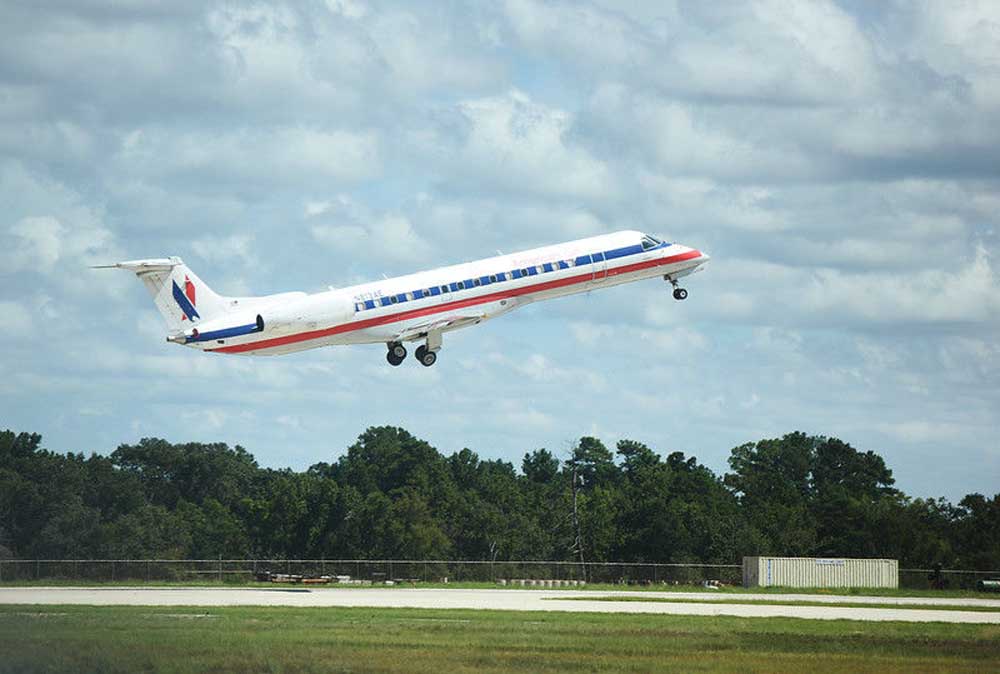Heightened airport security is a lasting effect of Sept. 11
Published 1:31 am Sunday, September 11, 2016

- An American Airlines aircraft takes off from Tyler Pounds Field to Dallas-Fort Worth Friday Sept. 9, 2016. After the terrorist attacks of 9/11 most airports, including Tyler Pounds Field, implemented high security measures. (Sarah A. Miller/Tyler Morning Telegraph)
Davis Dickson was making a presentation to the Airport Advisory Board at Tyler City Hall when his pager started buzzing. And it wouldn’t stop. Little by little, news leaked into the meeting – an accident of some sort, involving an airliner. No, an attack – and multiple planes.
“Pretty soon, the head of the committee told me to wrap it up,” Dickson recalls. “He knew I needed to get back to the airport.”
It was Sept. 11, 2001, and Dickson, the airport manager at Tyler Pounds Field since 1994, was instructed by the FAA to start locking down the airport.
“We had security measures, and they started with clearing the terminal,” he said. “We were in the old terminal still, so we cleared all non-essential personnel and then I went to the construction site of the new terminal (what’s now Tyler Pounds Regional Airport) and told the construction workers to leave.”
When the FAA instructed all aircraft to land immediately, at whatever field was closest, Pounds Field was ready.
“We didn’t have many, but we had a few regional airplanes,” Dickson said. “And we had gates that needed to be blocked off.”
The instructions from the FAA were nearly constant at first.
“We couldn’t let cars or general aviation aircraft get too close, for example,” Dickson said. “Even for a smaller airport, there was an enormous effort to sterilize the area – to make it free from threats.”
Much, much later on that long day, he walked over to the site of the new terminal building.
“I remember walking through the dirt of this site, I remember looking at this building, thinking about how much was going to change,” he said. “From a personal standpoint, I prayed we would all come together, and adapt to what’s going to change in the world.”
He looked back at the older terminal.
“I remember the sun was right behind me, and I could see the flag up on the top,” he said.
And he was right; everything changed. Flying in and out of Tyler Pounds Regional Airport (it changed the name in 2002) is a different experience.
At first, as Congress and President George W. Bush worked together to establish the Department of Homeland Security and the Transportation Security Administration, the National Guard took over security and passenger screening at all U.S. airports.
“One of the first things travelers saw that was new was a larger presence of armed security,” Dickson said. “Right after 9/11, we had armed military personnel at our checkpoints. They had uniforms, they had their rifles.”
Most passengers found it reassuring, he said. There was camaraderie in the suddenly long screening lines; everyone knew why the new measures were needed, and few complained.
“It has now become routine,” he said. “People are used to it, and in fact they can help. They’ll tell us if they see a piece of luggage that is unattended, and they’re much more aware of their surroundings.”
Still, there has been a tendency to become a little more lax in recent years, at least among passengers.
In fact, nationwide, more Americans are attempting to board planes with concealed firearms in their carry-ons. They also come with hidden swords, hatchets, sharpened ninja stars and even gunpowder.
Invariably, the response from passengers when officers from the Transportation Security Administration seize the weapons is: Oops, I forgot I had it.
“It’s always astonishing to me that people can forget they have a weapon in their carry-on,” said TSA Administrator Peter V. Neffenger. “I’m not sure why people continue to do this.”
Whether the reason is memory lapse or a desire to be prepared should armed terrorists once again try to commandeer an aircraft, the seizure of a record 2,653 firearms last year at airport checkpoints is but one aspect of an evolving security panorama as the nation passes the 15-year anniversary of the Sept. 11 attacks.
The security ritual now has a familiar rhythm: Shoes off. Laptops out. Everything through the X-ray machine. Nearly 2 million passengers endure the drill each day. Many hate it. A few get unruly.
The tools deployed by the security agents – including full-body scanners – get ever more sophisticated while the most basic of questions go without a satisfying answer: Do all the security measures work? Are terrorists truly deterred? Are we safe?
Experts agree on only one thing. Heightened airport security is here to stay, even at smaller airports.
“It’s really more of an effort to standardize security standards, though tactics vary day to day,” Dickson said. “The rules that apply at big airports can and should apply here. Every gateway to the system should have the same standard. And our procedures are updated and tested frequently.”
That’s just the new reality for air travel, he said.
“People are aware of what’s required of them now, and they’re cooperative,” he said. “That’s the world.”
The Associated Press contributed to this report.






